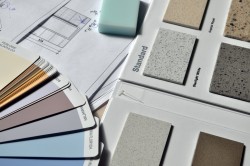Linoleum – Natural flooring since 1860
How is linoleum produced? Linoleum is the only resilient flooring made of renewable raw materials. It is made without artificial chemicals from linseed oil, resins, cork and wood flour, limestone flour and pigments. These components are blended into a mass and rolled onto a vegetable jute substrate under heat and pressure. What is the difference between linoleum and vinyl flooring? Linoleum and vinyl are two different types of flooring which are often confused, because they have a few similar characteristics. But there is one very important difference: While linoleum is made from natural and renewable resources, vinyl flooring is based on fossil, non-renewable resources. Where should linoleum flooring be used? From bedrooms to heavily used industrial floors, there are suitable linoleum floorings available for every purpose with a wide selection of colours and textures. Linoleum is particularly suitable for kitchens, entrances, corridors and storage rooms. What are the advantages of linoleum flooring? Linoleum has many positive properties, making it a versatile floor covering. It is robust, antistatic, resilient, colourfast, resistant to water, greases and oils, it is antibacterial and offers a soft, comfortable and warm walking surface. What are the disadvantages? Linoleum needs to be properly sealed to avoid damage by water. Linoleum flooring can be more expensive compared to vinyl flooring, but it offers a lot of advantages. In addition, linoleum flooring tends to last longer. Is linoleum flooring durable? Yes, linoleum is a durable flooring material and very resistant to scratches and damages. It can last 20-40 years depending on the environment and the intensity of traffic in an area. A linoleum floor can be reused. In addition, the material is completely biodegradable and can be disposed of without a problem. Can linoleum flooring be easily cleaned? Yes. It is sufficient for regular vacuuming and occasionally wiping the floor. The best option is to use special linoleum or other bio-based cleaners. Avoid harsh alkali chemicals and ammonia-based cleaning agents. Is linoleum flooring available in different colours and forms? While the classic linoleum of the 1950s and 1960s was mostly coloured beige, gray, blue or red, nowadays linoleum is available in numerous decors, patterns and rich colours. How is linoleum applied? Linoleum is available either in tiles and planks or as sheet linoleum. The best option when it comes to environmental and health protection is the untreated sheet linoleum, but it is more complicated to install and will probably need the assistance of a professional. For installing sheet linoleum natural resin or casein universal adhesives are recommended. These are largely free of harmful substances and have proven themselves over decades. The other option is to use linoleum tiles with tongue and groove click connection, which is laid floating. In this case no adhesives are needed. You can always recombine different colours or take your linoleum with you when moving to a different place. However, this option is moisture sensitive and should be sealed. A recent Dutch invention is liquid self-leveling linoleum (liquid lino), which is applied seamlessly on site. By adding a hybrid extra vegetable-based binder the liquid lino sets overnight.
Keywords
Countries
Netherlands



